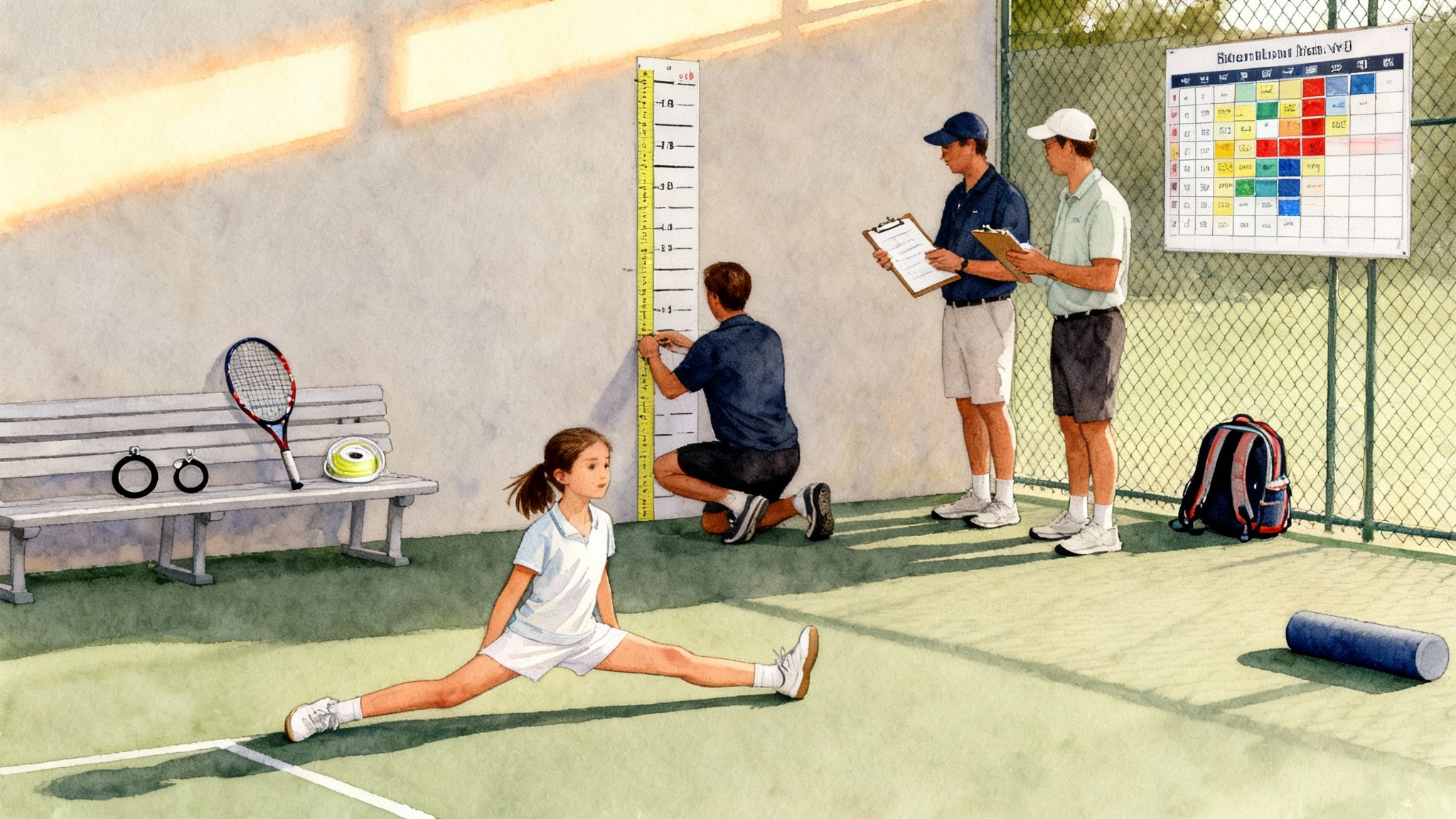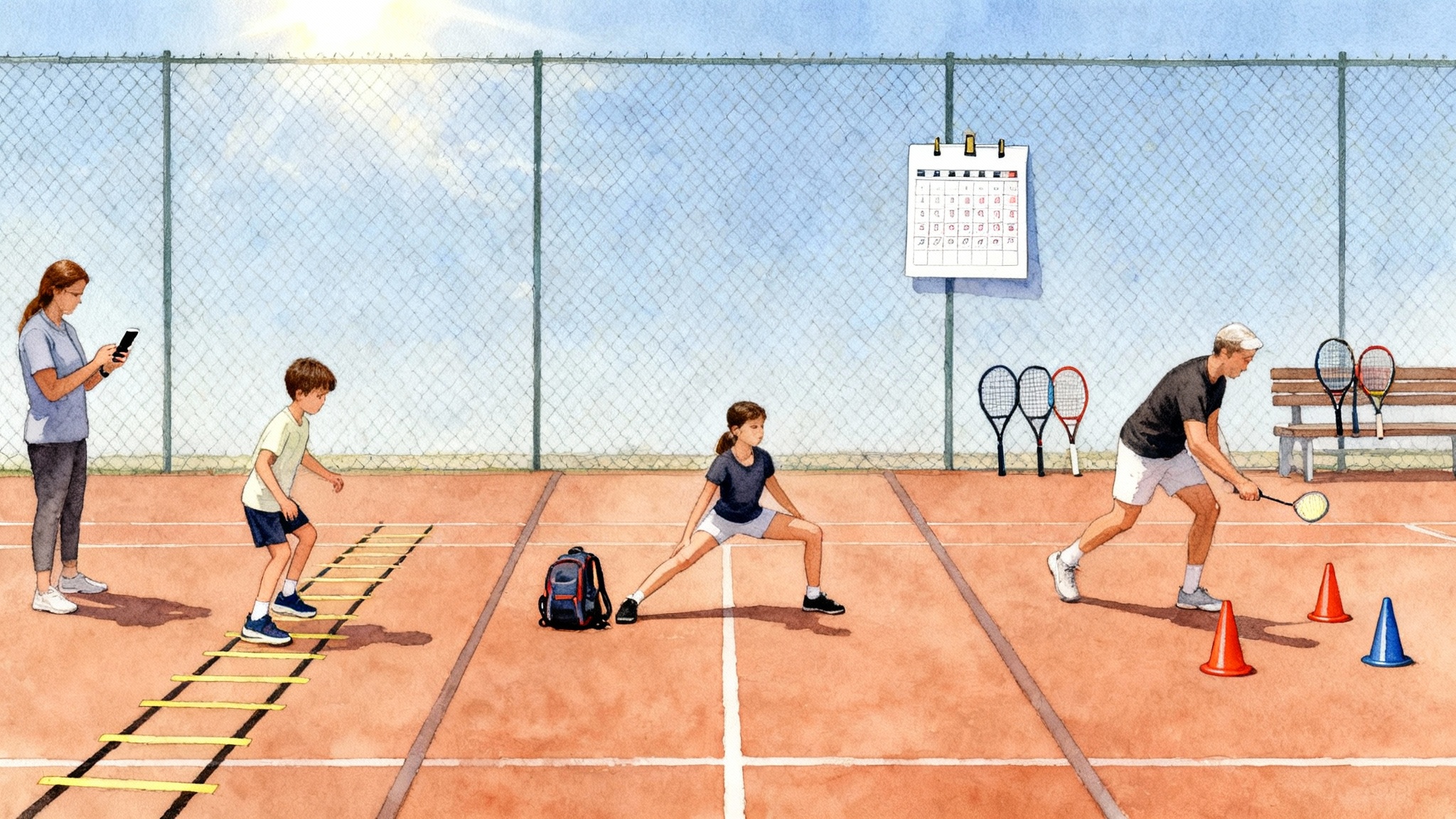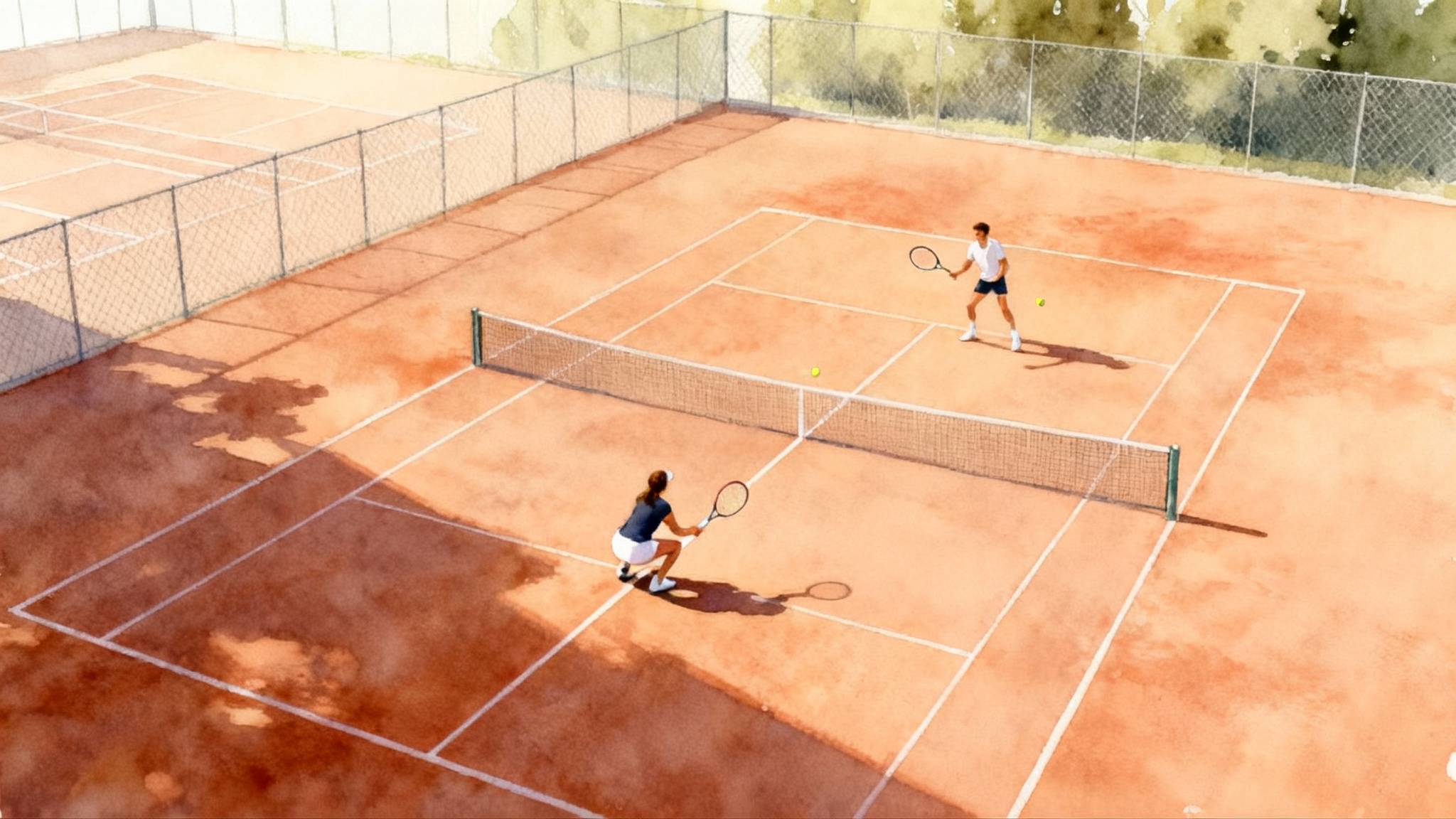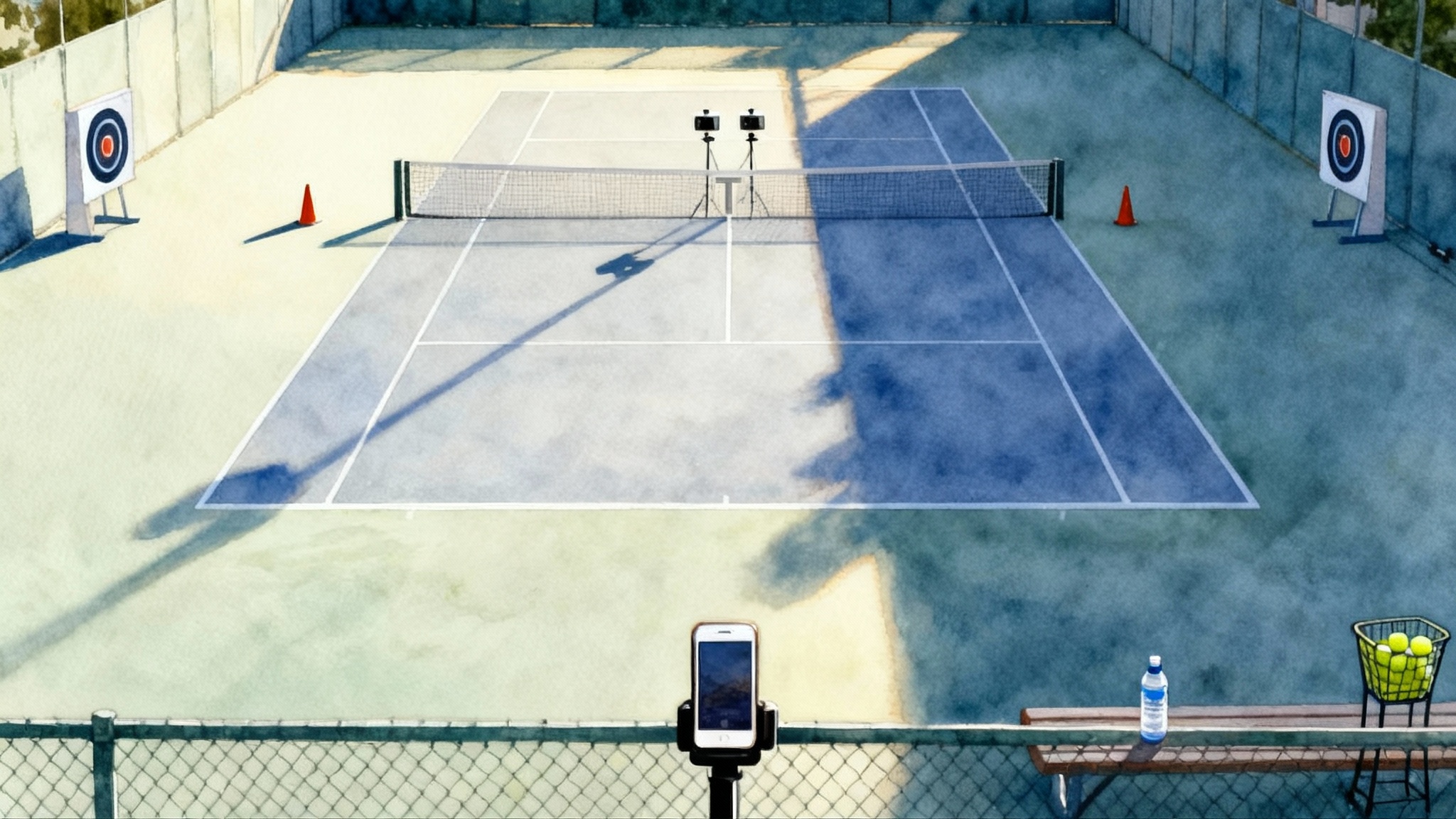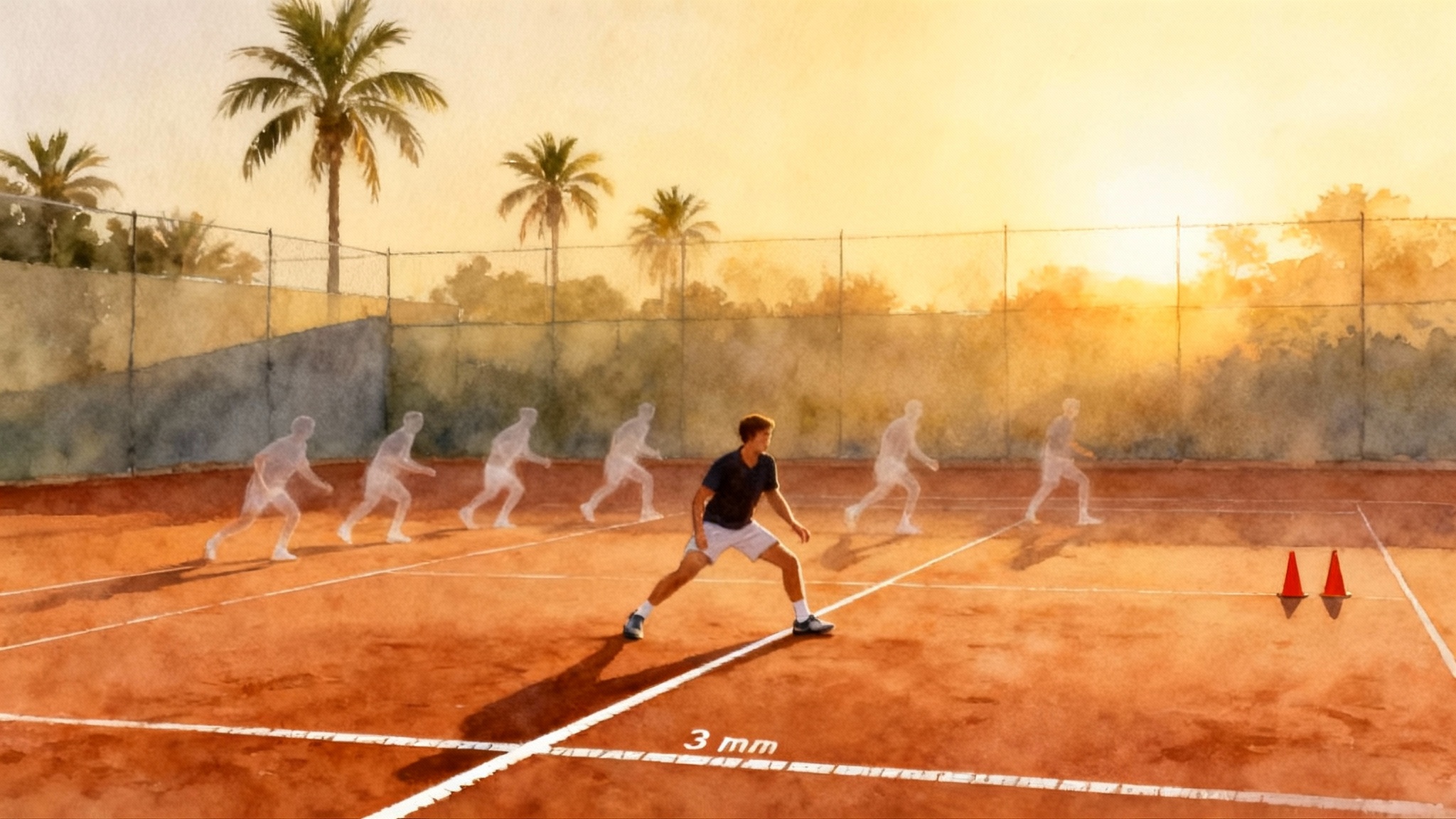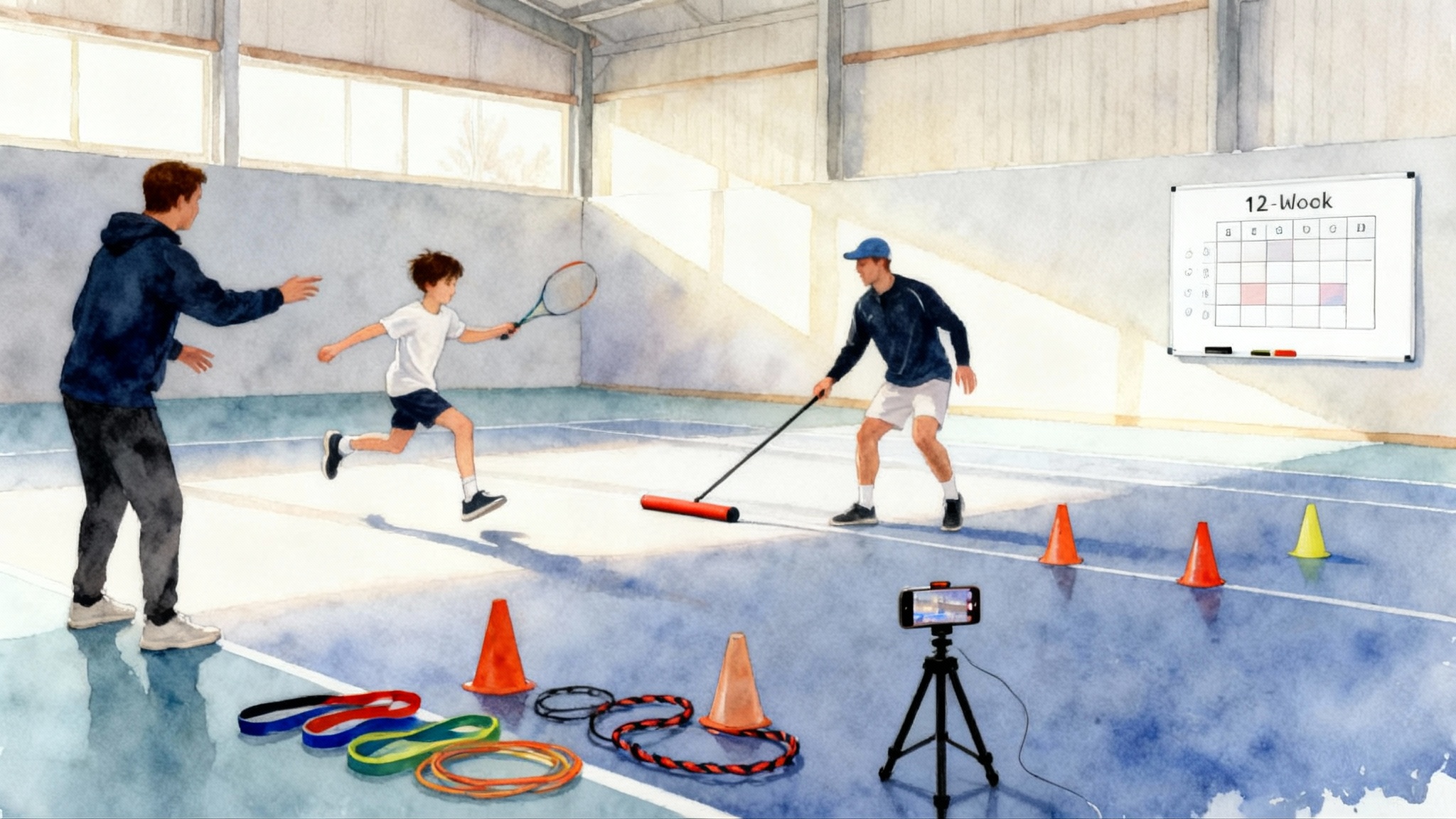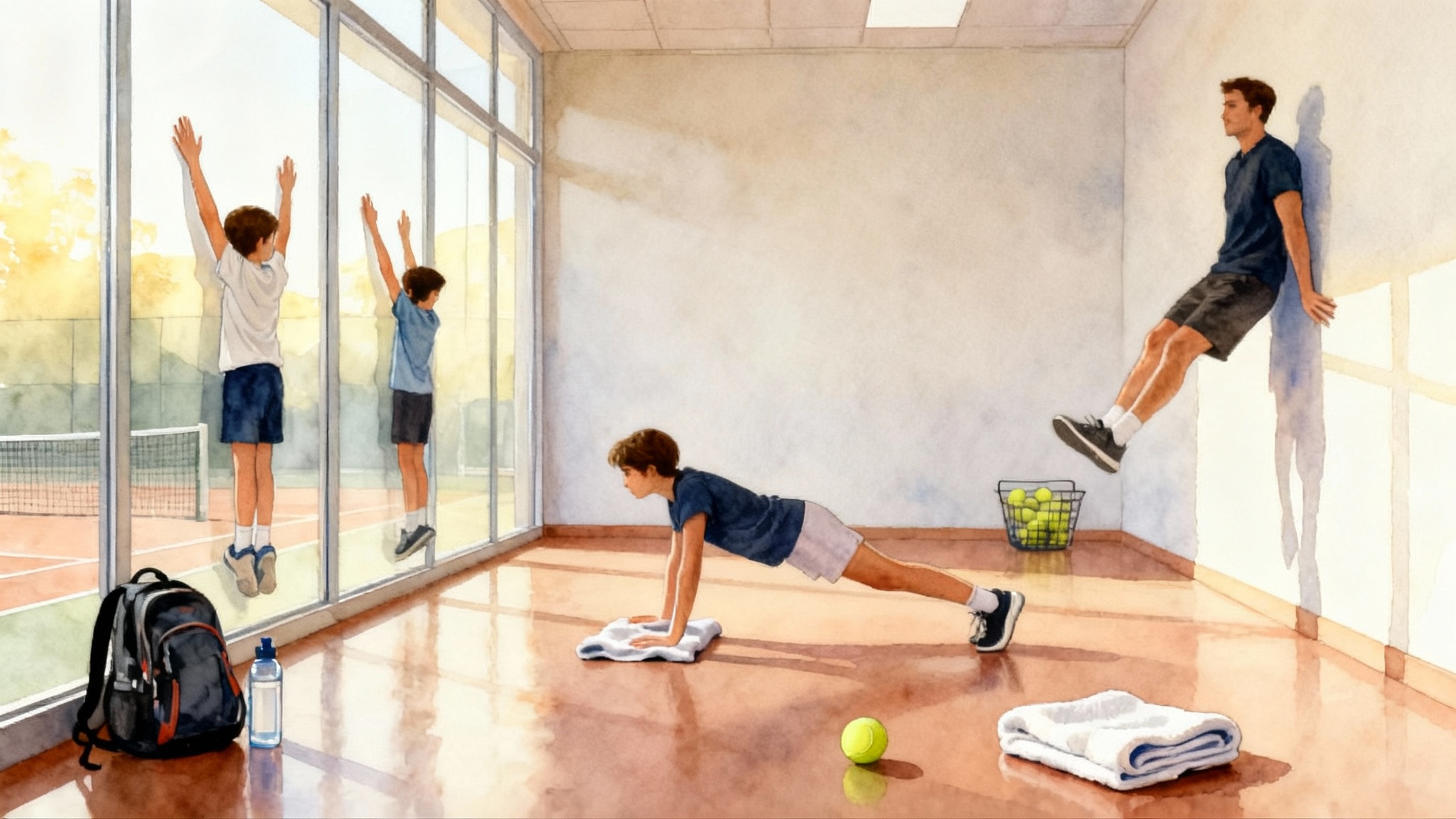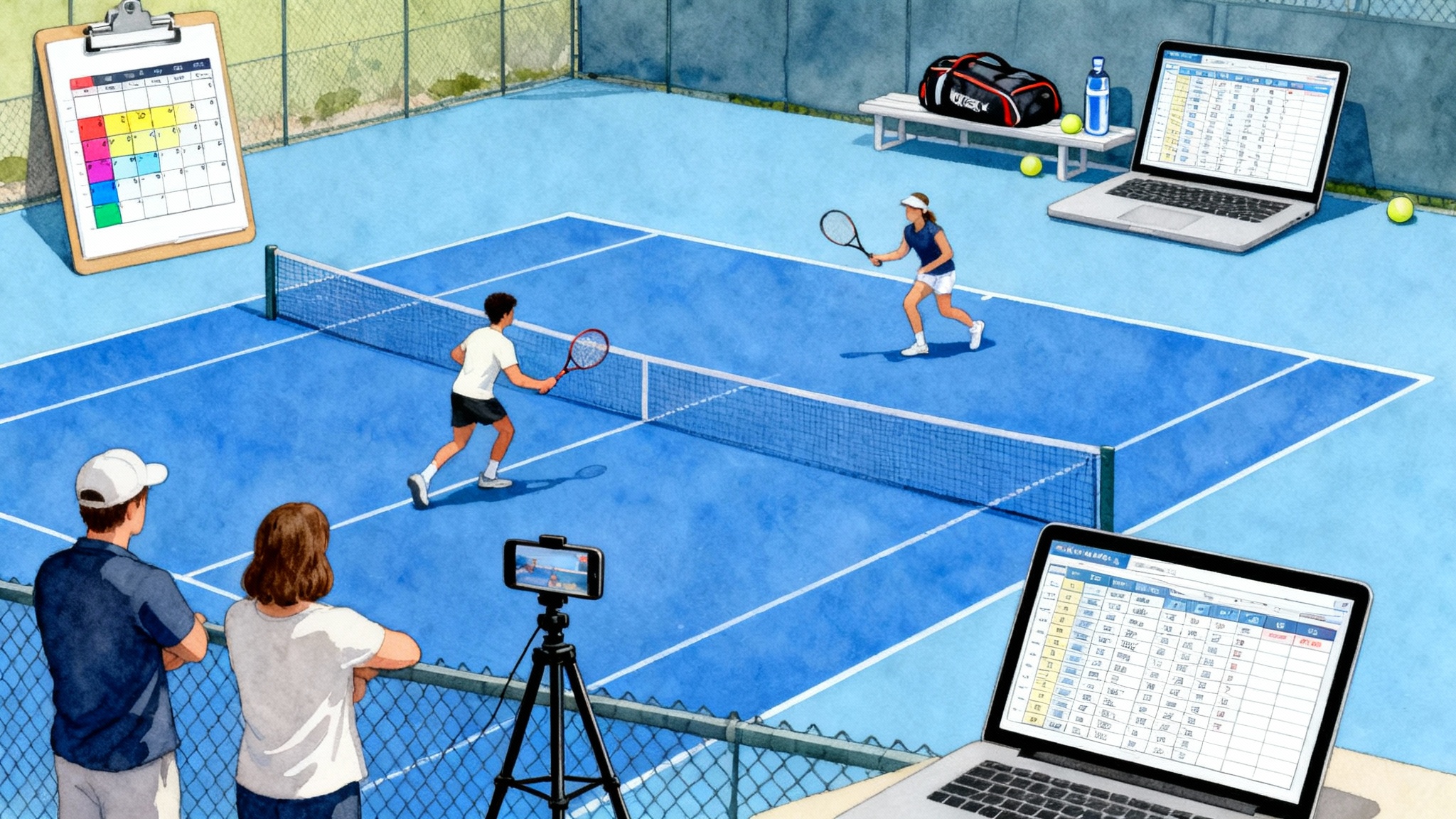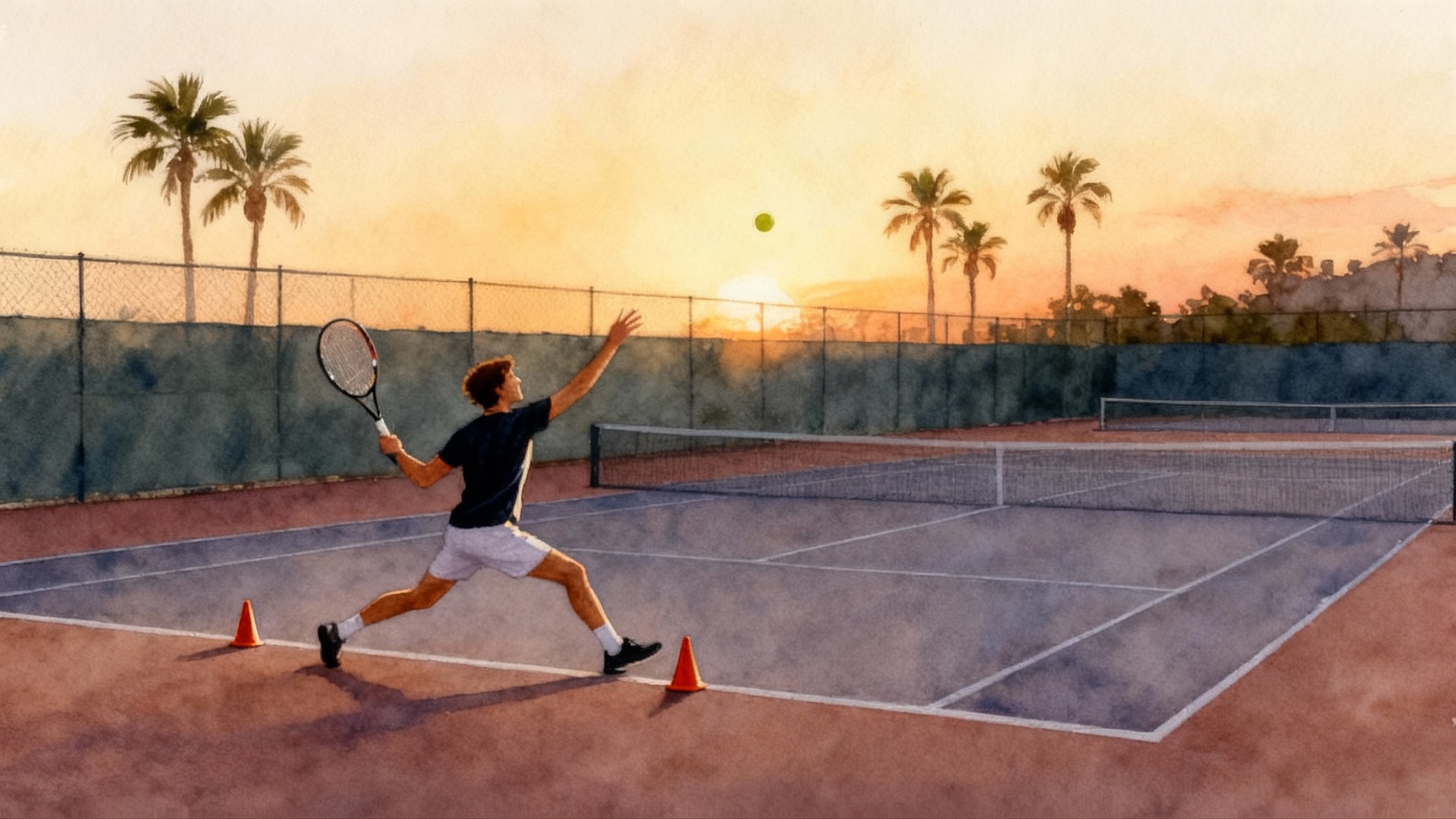Tennis 2025: Deceleration and Elite Change of Direction Skills
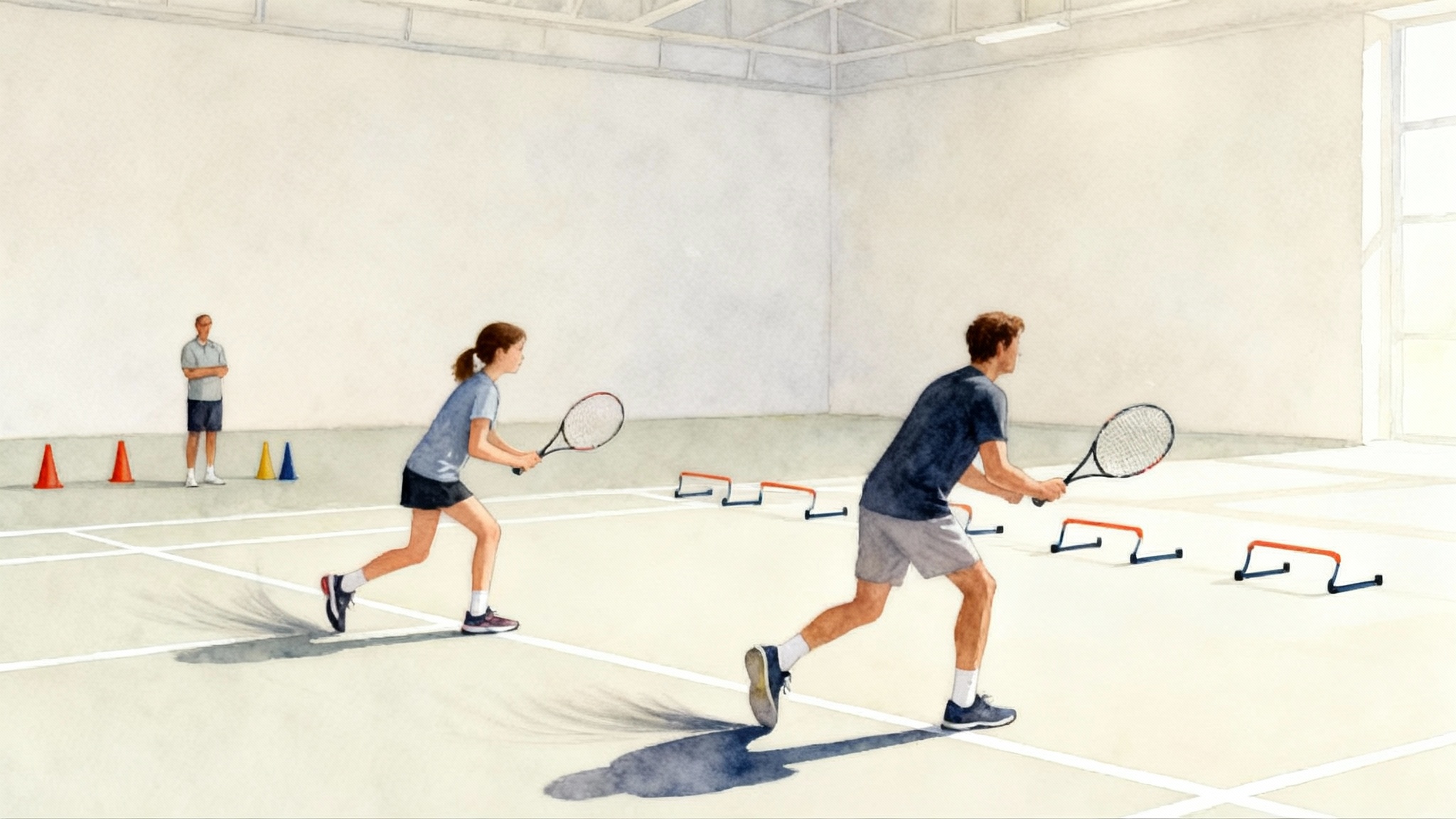
Why tennis speed is built on braking
Every explosive change in tennis starts with a quality stop. The faster you can decelerate, the sooner you can put force back into the court and go again. Players who struggle to brake slide long past contact points, arrive late to the next ball, and accumulate unnecessary joint stress. Players who master braking get a cleaner split step, shorter steps into the ball, and a sharper first step out. For more footwork context, see our split step to shuffle guide.
This article gives you a clear, age-specific blueprint for 2025. The focus is simple and practical. Teach the two anchor mechanics that matter most, layer in eccentric strength, add low dose plyometrics, and protect the schedule with ten minute warm ups and weekly micro-sessions. We include at-home and on-court drills, phone-video checkpoints for parents, and a direct path for how these skills translate to college and professional readiness. Life Time Tennis Academy offers year-round courts and integrated strength and conditioning support to make this plan consistent in every season.
The two anchors: shin angle and center of mass
Think of your body as a tripod during a stop: the plant foot, the hip over that foot, and the trunk stacked slightly inside the turn. Two cues create that tripod.
- Shin angle: at the plant step, the shin of the outside leg should point slightly toward the direction you intend to go next. A forward-leaning shin acts like a shock absorber and a directional pointer. If the shin is vertical or leaning backward, you skid and lose time.
- Center of mass control: your belly button should travel over the plant foot, not outside it. When your hips ride inside the foot, the knee collapses inward and the stop gets sloppy. When your hips stack over the foot, the joints share the load and you can re-accelerate with a crisp push.
Simple self-check: freeze for half a second at the deepest part of your stop. If someone took a photo, would the ankle, knee, and hip of the plant leg form a line that points where you plan to go next, with the chest slightly inside that line? If yes, you are braked and primed.
The ten minute warm up that sets your brakes
You can set up quality stopping mechanics before the first ball. Use this short sequence. It fits on the sideline, in a hallway, or by the baseline.
- Tissue prep, 90 seconds total
- 30 seconds each calf and adductors with a light roll or massage stick
- 30 seconds of ankle rocks, 10 per side
- Dynamic range, 3 minutes
- Walking knee hug to heel raise, 10 steps per side
- Lateral lunge with reach, 8 per side
- World’s greatest lunge with thoracic rotation, 4 per side
- Braking pattern primers, 3 minutes
- Two step approach into hop and stick on outside leg, hold 2 seconds, 5 per side
- Skater hop and stick, small distance, 5 per side
- Tall split step to drop and stick, 6 total
- Elastic switch on, 2 minutes
- In place low pogo jumps, 2 sets of 12
- Two quick steps into plant and freeze, 2 sets of 3 each side
The goal is not fatigue. The goal is rehearsal. Every hold teaches your body where strong positions live.
Eccentric strength is your brake pad
Eccentric strength means controlling the lowering phase. It is what keeps you from crashing into a stop. Two low-tech options build a lot of braking capacity.
- Nordics for hamstrings: anchor your heels under a partner’s grip or a sturdy couch. Keep the body straight from knee to shoulder. Lean forward slowly for 3 to 5 seconds, catch with hands, push lightly off the floor, and return to tall. Start with 2 sets of 3 to 5 reps twice per week. Progress to 3 sets of 5 to 6 over four to six weeks. If you cannot control the descent yet, reduce range or hold a band attached in front to help.
- Tempo split squats for quads and hips: step into a long split stance. Lower in 4 seconds, pause 1 second above the floor, rise in 1 to 2 seconds. Keep the front shin angled slightly forward while the knee tracks over the toes. Start with bodyweight, 2 sets of 6 per side. Progress to 3 sets of 8 to 10 with dumbbells over time.
Pair these with calf-eccentric work. Stand on a step. Two feet up, one foot down in 3 seconds. 2 to 3 sets of 8 per side. Strong calves stabilize the ankle and shorten ground contact time during re-acceleration.
Low dose plyometrics sharpen the edge
Plyometrics are powerful when dosed carefully. The goal is crisp contacts, soft landings, and clean shapes, not exhaustion.
- Beginners and juniors 8 to 12: 2 sets of 4 to 6 contacts per drill, 2 to 3 drills, twice per week. Focus on hop and stick varieties and short lateral bounds.
- Teens 13 to 17 with training age: 3 sets of 6 to 8 contacts per drill, twice per week. Add low hurdles, short-depth drops, and lateral to forward transitions.
- Adults: micro-dose year round. 2 sets of 6 to 8 total contacts, two or three times per week, before tennis or lifting. Keep contacts low and quality high.
Examples: low pogo jumps, snap downs with jump, lateral skater bounds, short depth drop to stick, and lateral bound to forward sprint. Keep total ground contacts modest on match days.
On-court drills that teach the turn
You do not need a full ladder of equipment. A few cones and mindful coaching go a long way.
- Red light plant and go
- Set two cones 12 to 18 feet apart along the baseline. Shuffle to the outside cone, plant on the outside foot, hold a two count, then spring back. 3 by 20 seconds each side. Coach or partner calls red to freeze, green to go.
- Cues: knee tracks over middle toes, hip stacks over foot, chest slightly inside the turn.
- V-cut forehand turn
- Place three cones in a V shape, point toward the sideline. Feed a ball to the wide cone. Player sprints out, decelerates into a forehand stance, hits, then drives back to the middle cone. 4 to 6 reps per side.
- Cues: smooth steps into the last two strides, outside foot plants with forward shin angle, first step back is short and fast.
- Lateral to forward U turn
- Start at the hash mark. Shuffle laterally, plant outside foot at the sideline cone, and turn the hips forward into a sprint to the service line. 3 sets of 4 reps per side.
- Cues: eyes and chest turn with the hips once the stop is secure. Do not twist before you are stable.
- Split step clock
- Place small markers at 10, 12, and 2 o’clock in front of the split step position. On a visual cue, land the split step, brake softly, and push toward the called marker. 3 by 10 landings.
- Cues: land tall, sink into the hips, then push. Quiet feet beat loud feet.
At-home drills for juniors and time-crunched adults
Home sessions keep the pattern alive between practices. Use floors with grip and a clear five to eight foot lane.
- Wall shin control
Stand one foot length from a wall. Drive the knee forward to touch the wall without lifting the heel. 2 sets of 8 per side. Builds ankle range and teaches shin angle control. - Couch Nordics
As described above. Anchor under the couch and control the lean. 2 to 3 short sets. - Skater hop and stick line
Tape a line on the floor. Hop over and stick. 2 by 6 per side. Hold still before returning. - Slow motion turn steps
Take two approach steps, plant the outside foot, freeze for a two count, then take two forward steps. Repeat for 60 seconds per side. This builds awareness for the transition from braking to go-time.
Phone-video checkpoints for parents
You can give high quality feedback with a phone in five minutes. For deeper workflows, see our phone and smart-court video playbook.
- Setup
Use the rear camera at 60 frames per second if available. Place the phone on a small tripod or a knee-high bench, about 15 feet from the lane and 90 degrees to the movement. - Angles
Side view for shin angle and trunk position during the plant. Rear view for knee tracking over the foot. - What to pause and check
At the deepest part of the stop, draw a simple mental line from the ankle through the knee to the hip. The line should point toward the next direction of travel. The knee should track over the middle toes, not collapse inside. The chest should be slightly inside the turn, not leaning away. - Scoring
Give a simple 1 to 3. One means shape is off, two means shape is close, three means crisp. Re-shoot one rep to improve the score.
Age-specific blueprint
Below is a practical, week-by-week structure for three groups. This is not a maximal plan. It is realistic and repeatable.
Juniors 8 to 12
- Warm up: the ten minute sequence above, every session.
- Strength focus, twice per week at the end of practice
- Nordics 2 by 3 to 4, tempo split squats 2 by 6 per side, calf eccentrics 2 by 8 per side
- Micro mobility: ankle rocks and lateral lunge reach, 1 minute total
- Plyometrics, twice per week before tennis
- Hop and stick 2 by 4 per side, skater hop and stick 2 by 4 per side
- On-court change-of-direction, twice per week
- Red light plant and go, V-cut forehand turn, 3 to 4 short sets
- Home habit, once per week
- Wall shin control and slow motion turn steps, 5 minutes total
Progression rule: do not add speed until the holds are stable. A clean two second balance is the green light.
Teens 13 to 17
- Warm up: the ten minute sequence above, each training day.
- Strength focus, two to three times per week
- Nordics 3 by 4 to 6, tempo split squats 3 by 8 to 10, calf eccentrics 3 by 8
- Add split squat isometrics at mid-range, 2 by 20 seconds per side for tendon health
- Plyometrics, twice per week
- Lateral bound to stick 3 by 6 per side, short depth drop to stick 3 by 4, lateral to forward transition 3 by 4
- On-court change-of-direction, twice per week
- Lateral to forward U turn and split step clock, 3 to 4 sets
- Speed micro-dose after match play
- Two sets of low pogos and two quick plants and go, under two minutes total
Progression rule: add an implement only after mechanics are repeatable. Mini hurdles or a light medicine ball throw after the stick can be introduced in weeks 4 to 6.
Adults 18 and up
Adults benefit from micro-sessions. They fit into busy schedules and keep joints happy.
- Weekly micro-sessions, 10 to 12 minutes, two to three times per week
- Session A
- Warm up blocks 1 and 3 from the sequence above, 5 minutes
- Tempo split squat 2 by 6 per side
- Hop and stick 2 by 4 per side
- Session B
- Warm up blocks 2 and 4, 5 minutes
- Nordics 2 by 3 to 5
- Skater hop and stick 2 by 4 per side
- Optional Session C
- Red light plant and go, 3 by 20 seconds per side
- Calf eccentrics 2 by 8 per side
- Session A
Progression rule: keep contacts low and quality high, especially on weeks with extra match play. If knees or Achilles feel hot, cut contacts by half and keep only the holds and tempo strength.
From good stops to college and tour readiness
College and professional tennis reward repeatable positions under fatigue. Clean deceleration is the bridge between defense and offense.
- Better split steps: strong calves and hamstrings shorten the land-to-launch time of a split step. A quiet, tall landing sets a precise first push.
- Tighter contact windows: with a reliable outside foot plant, you take fewer stutter steps and arrive balanced in fewer strides. This consistency stabilizes stroke mechanics.
- Faster pattern switches: rallies often demand a lateral stop into a forward burst. Players who manage shin angle and center of mass align the hips faster, so the body turns with the ball rather than chasing it.
- Durability across tournaments: eccentric capacity is protective. When braking loads are shared across ankle, knee, and hip, the tissues tolerate long weekends better and recover faster between matches.
Recruiters and coaches notice movement that looks efficient and calm. When you can plant, hold, and go on command, you look ready for college court pace. On the tour, where depth and pace are relentless, the ability to stop hard and restart cleanly is a competitive necessity.
How to implement this at Life Time Tennis Academy
Life Time Tennis Academy offers indoor and outdoor courts through the full calendar, which means you can maintain braking work during winter and summer transitions without losing surface feel. Their strength and conditioning team can help you dose Nordics, tempo split squats, and plyometrics so that workloads match your match schedule and development stage. If you need a facility partner with space for cones, mini-hurdles, and sprint lanes, and a coaching staff that can coordinate on-court and gym work, consider booking a consult through Life Time Tennis programs.
A typical academy integration looks like this.
- Assessment block, week 1
- Ten minute warm up filmed from the side and rear
- Two plant and go drills per side, graded on shape and quietness
- Calf and hamstring strength checks
- Build block, weeks 2 to 6
- Two ten minute warm ups plus two braking micro blocks per week on court
- Two strength sessions per week in the gym, 30 to 35 minutes, with eccentric emphasis
- Video check once per week for shin angle and center of mass control
- Maintain block, weeks 7 and beyond
- Micro-dose plyometrics before practices and matches
- Rotate in isometrics for tendon health during tournament runs
Communication matters. Coaches, parents, and players should share two numbers each week: total contacts from plyometrics and total sets of Nordics. These two metrics predict most of the load that your braking system sees. Adjust either up or down by about 10 to 15 percent per week, not more.
Safety, surfaces, and shoes
- Surfaces: teach holds on a stable surface first, then progress to the actual match surface. Hardwood or resilient indoor courts feel faster and may demand an extra practice session for new players before full-speed drills.
- Shoes: a firm heel counter and secure lacing keep the foot from sliding during the plant. Replace worn shoes before they lose grip or structure.
- Volume: stops accumulate load. Track contacts and total sets. Err on the side of fewer, cleaner reps instead of many noisy ones.
- Soreness: hamstrings and calves will feel worked after Nordics and calf eccentrics. That is normal. Sharp pain is not. If soreness persists more than 48 hours, cut the next session volume in half and focus on holds.
A one page checklist you can screenshot
- Shin angle points where you plan to go.
- Belly button stays over the plant foot during the deepest part of the stop.
- Quiet landings, short first step out.
- Two to three short strength lifts per week with eccentric focus.
- Low dose plyometrics that you can count on one hand.
- Ten minute warm up that never gets skipped.
- One video angle from the side, one from the rear, each week.
Troubleshooting common errors
- The knee caves in during the plant
Reduce speed, shorten the approach steps, and add a two second hold on the stick. Add an extra set of tempo split squats with a slow lower. - You feel like you are sliding past the ball
Look at the last two steps before the stop. They should be slightly shorter and quicker. Cue yourself to organize the hips over the foot before the torso turns to hit. - You spring out slowly after a good stop
Add low pogo jumps and calf eccentrics for two weeks. Keep the first step short and fast rather than long and reaching.
Put it all together in seven days
Here is a simple week that fits school, work, and match play.
- Monday
Ten minute warm up
Strength: Nordics 3 by 4, tempo split squats 3 by 8 per side, calf eccentrics 3 by 8 per side - Tuesday
On-court: red light plant and go, split step clock, 3 short sets
Plyometrics: hop and stick 2 by 4 per side - Wednesday
Rest or easy mobility and wall shin control - Thursday
Ten minute warm up
On-court: V-cut forehand turn and lateral to forward U turn, 4 to 6 reps per side - Friday
Strength: Nordics 2 by 5, split squat isometrics 2 by 20 seconds per side, calf eccentrics 2 by 8 - Saturday
Match or practice with two set plyometric micro-dose before first ball - Sunday
Five minute home routine and two quick video reps for the side and rear views
This template scales. Juniors cut the total sets in half. Adults on tight schedules can compress Monday and Thursday by removing one set from each drill.
The finish line
Speed in tennis is not only how fast you can go. It is how cleanly you can stop, choose, and go again. Teach shin angle and center of mass control, build eccentric strength with Nordics and tempo split squats, and sharpen your edge with low dose plyometrics. Protect it all with a ten minute warm up and steady micro-sessions. Parents can film, coaches can cue, and players can own the shapes that make movement look effortless. With year-round courts and integrated strength and conditioning support, Life Time Tennis Academy is a practical home to turn this blueprint into a reliable competitive advantage. The result is simple. Fewer wasted steps, crisper turns, and the kind of speed that holds up in long rallies, college pressure, and professional pace.
